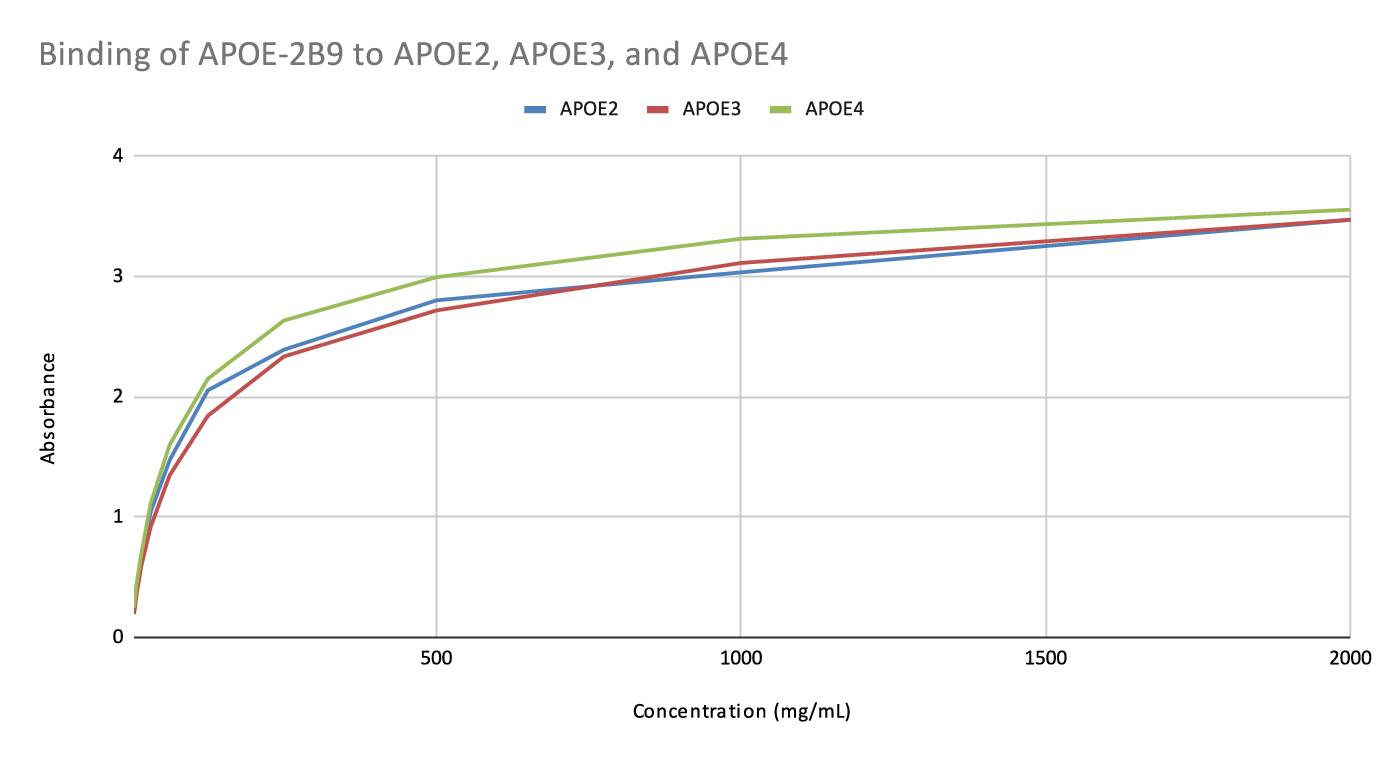Anti-Human ApoE (Pan) – Purified No Carrier Protein
Data
- -
- -
Antibody DetailsProduct DetailsReactive Species Human Expression Host HEK-293 Cells Immunogen Recombinant Human ApoE protein Product Concentration ≥1.0 mg/ml Purity ≥90% monomer by analytical SEC and SDS-Page Formulation This recombinant monoclonal antibody is aseptically packaged and formulated in 0.01 M phosphate buffered saline (150 mM NaCl) PBS pH 7.2 - 7.4 with no carrier protein, potassium, calcium or preservatives added. Due to inherent biochemical properties of antibodies, certain products may be prone to precipitation over time. Precipitation may be removed by aseptic centrifugation and/or filtration. State of Matter Liquid Product Preparation Recombinant antibodies are manufactured in an animal free facility using only in vitro protein free cell culture techniques and are purified by a multi-step process including the use of protein A or G to assure extremely low levels of endotoxins, leachable protein A or aggregates. Storage and Handling Antibodies may be stored sterile as received at 2-8°C for up to one year. For longer term storage, aseptically aliquot in working volumes without diluting and store at ≥ -80°C. Avoid Repeated Freeze Thaw Cycles. Regulatory Status Research Use Only Country of Origin USA Shipping 2 – 8° C Wet Ice Applications and Recommended Usage? Quality Tested by Leinco ELISA
WB Each investigator should determine their own optimal working dilution for specific applications. See directions on lot specific datasheets, as information may periodically change. DescriptionDescriptionSpecificity Clone ApoE-2B9 binds to all three isoforms (E2, E3, and E4) of human apolipoprotein E (ApoE). Background ApoE is a 299-amino acid multifunctional protein primarily synthesized in the liver, but also produced by other tissues including the brain. It is a major component of several classes of lipoproteins, including chylomicron remnants, very low-density lipoproteins (VLDL), intermediate-density lipoproteins (IDL), and some high-density lipoproteins (HDL)1. It plays a crucial role in lipid metabolism and has significant implications for various diseases, particularly neurodegenerative disorders1. The primary function of ApoE is to mediate the binding of lipoproteins to specific cell-surface receptors, particularly the low-density lipoprotein receptor (LDLR). This interaction is essential for the normal processing and catabolism of triglyceride-rich lipoproteins1. In the central nervous system, ApoE is mainly produced by astrocytes and plays a crucial role in transporting cholesterol to neurons via ApoE receptors1. There are three major isoforms of ApoE in humans: ApoE2, ApoE3, and ApoE4. These isoforms differ by only one or two amino acids at positions 112 and 158, but these small differences have significant impacts on their structure and function1. The ApoE genotype has been strongly associated with various diseases: 1. Alzheimer's Disease: The ApoE4 isoform is the strongest genetic risk factor for late-onset Alzheimer's disease. Individuals carrying one copy of the ApoE4 allele have a 3-4 fold increased risk, while those with two copies have a 12-15 fold increased risk1. 2. Cardiovascular Disease: ApoE plays a role in atherosclerosis and cardiovascular disease risk. The ApoE4 isoform is associated with higher levels of LDL cholesterol and increased risk of coronary heart disease1. 3. Lipid Disorders: The ApoE2 isoform is associated with type III hyperlipoproteinemia, a rare lipid disorder characterized by elevated levels of cholesterol and triglycerides. 4. Other Neurological Conditions: ApoE has been implicated in other neurological disorders, including Parkinson's disease, multiple sclerosis, and traumatic brain injury1. The mechanisms by which ApoE influences disease risk are complex and not fully understood. In Alzheimer's disease, for example, ApoE4 is thought to affect amyloid-β aggregation and clearance, tau phosphorylation, neuroinflammation, and synaptic plasticity1. Antigen Distribution ApoE is produced differentially in the central nervous system by astrocytes and microglia as well as peripherally by the liver and macrophages. ApoE does not cross the blood–brain barrier. NCBI Gene Bank ID UniProt.org Research Area Cell Biology . Neuroscience . IVD Raw Material References & Citations1. Huang Y, Mahley RW.Neurobiol Dis. 2014 Dec;72 Pt A:3-12. Technical ProtocolsCertificate of Analysis |
Formats Available
- -
- -
Prod No. | Description |
|---|---|
A459 | |
A458 |



